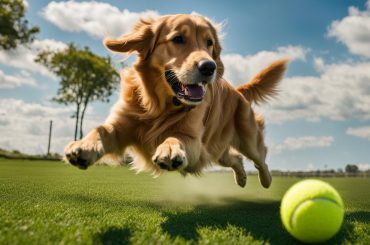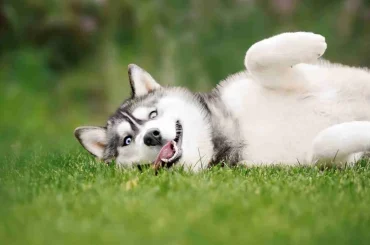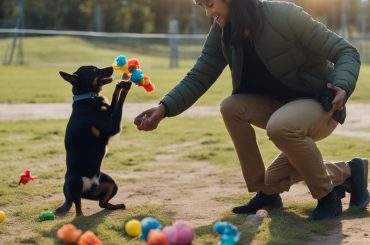Teaching your dog to find things is a practical and impressive skill that involves scent tracking. It can be a fun game to play with your dog and can come in handy when you need to locate lost items. This trick can be taught to dogs of all breeds and ages, although adult dogs may have an easier time focusing on the task. You will need a favorite toy or an item that smells strongly of you, treats, and patience.
Key Takeaways:
- Teaching your dog to find things involves scent tracking and can be a fun and practical skill to learn.
- Any dog can learn this trick, but patience, consistency, and rewards are key.
- You will need a favorite toy or item that smells like you, treats, and patience to train your dog.
- Adult dogs may have an easier time focusing on the task of finding objects.
- Try to make the training sessions enjoyable for both you and your dog.
The Practical Side of Teaching Your Dog to Find Things
Teaching your dog to find things not only allows them to show off their natural scent detection abilities but also serves a practical purpose. By training your dog to find specific objects, such as car keys or clothing items, you can save time searching for lost items. This skill is particularly useful for breeds with a strong sense of smell, such as beagles and bloodhounds, but can be taught to any dog with patience and consistent training.
Canine search skills can be honed through teaching dogs to search for specific scents, making them valuable in various situations. Whether you need to locate a misplaced item in your home or assist with search and rescue efforts, a dog trained in scent detection can be a valuable asset. This skill taps into their innate abilities and gives them a clear task to focus on, providing mental stimulation and a sense of purpose.
Teaching your dog to find objects and scents not only enhances their natural abilities but also strengthens the bond between you and your furry companion. It requires patience, consistency, and rewards to keep them motivated. With practice, your dog can become proficient in locating items and scents, making them a reliable partner in your daily life and potential emergency situations.

Table: Comparing Canine Search Skills
| Skill | Benefits |
|---|---|
| Teaching Dogs to Find Objects | – Time-saving – Practical use in locating lost items – Mental stimulation |
| Teaching Dogs to Search for Specific Scents | – Valuable in search and rescue efforts – Mental stimulation and purpose – Enhanced bond between dog and owner |
Getting Started: The Tools You Will Need
To teach your dog to find things, you will need a few essential tools. These include a favorite toy or an item that smells strongly of you, such as a hat or a T-shirt. Treats will be used as rewards for your dog’s successful searches. It is also helpful to have a collar and leash or a friend who can hold the dog for you during the training sessions. Try to make the training sessions into a game to keep your dog engaged and motivated.
Table: Essential Tools for Teaching Your Dog to Find Things
| Tools | Description |
|---|---|
| Favorite Toy or Item with Your Scent | An item that your dog is familiar with and strongly associates with you will help them understand the task better. |
| Treats | Use small, bite-sized treats to reward your dog for successful searches. Choose treats that are enticing and easy to consume. |
| Collar and Leash | If you don’t have someone to assist you, a collar and leash will help you control your dog’s movements during training sessions. |
“Training sessions should be enjoyable and engaging for your dog. Turning it into a game will keep them motivated to participate.”
To put it simply, dogs learn best through positive reinforcement, so be patient and celebrate their progress. By providing the right tools and creating a fun and rewarding learning environment, you can successfully teach your dog to find things.
Teaching Your Dog to Find Objects

To teach your dog to find objects, I would advise that you start with a strong foundation. Begin by introducing your dog to the object you want them to find. Let them sniff and interact with it, creating a positive association. This helps them understand that finding the object is a rewarding task.
Once your dog is familiar with the object, it’s time to start hiding it in easy-to-find locations. Give the command “Go find” or use the object’s name if your dog already knows it. Encourage them to search for the object and provide verbal cues or gestures to guide them if needed.
When your dog successfully finds the object, celebrate their achievement with praise and rewards. Use treats or their favorite toy as a positive reinforcement. This helps reinforce their understanding that finding objects is a desirable behavior.
Teaching Your Dog Scent Tracking
Teaching your dog scent tracking is a valuable skill that taps into their natural abilities. This training involves having your dog use their sense of smell to locate specific scents or objects. Scent detection training for dogs can be both practical and fun, providing mental stimulation and strengthening the bond between you and your furry friend. By following a few simple steps, you can teach your dog to search for specific scents effectively.
Start by introducing your dog to the scent you want them to track. This can be done by letting them sniff an object that has the desired scent. Once they are familiar with the scent, hide the scented object in an easy location and give the command “Go find” or use the name of the object. When your dog successfully locates the scent, reward them with a treat and praise. Repeat this process, gradually increasing the difficulty of the hiding spots and using objects with different scents to challenge your dog’s olfactory skills.
Consistency is key in scent tracking training. Set aside regular training sessions to reinforce the skills your dog is learning. Use positive reinforcement techniques, such as treats and praise, to motivate and reward your dog for their successful searches. Make the training sessions engaging and enjoyable by turning them into a game. As your dog becomes more proficient in scent tracking, you can increase the complexity of the tasks, incorporating different scents and challenging hiding spots.
To put it simply, every dog learns at their own pace. Be patient and understanding during the training process. Celebrate your dog’s progress, no matter how small, and continue to work together to improve their scent tracking skills. With consistent training and practice, your dog will become a proficient scent tracker, impressing you and others with their natural abilities.
| Tips for Teaching Your Dog Scent Tracking |
|---|
| Start with familiar scents and gradually introduce new ones to keep your dog engaged and challenged. |
| Use positive reinforcement, such as treats and praise, to motivate and reward your dog for their successful searches. |
| Make training sessions fun and engaging by turning them into a game. |
| Be patient and understanding, as every dog learns at their own pace. |
| Celebrate your dog’s progress, no matter how small, to build their confidence and encourage further learning. |
Advanced Training: Retrieving Lost Items
Once your dog has mastered finding objects and scent tracking, you can advance to teaching them to retrieve lost items. This skill is particularly useful in search and rescue scenarios or when you need assistance in locating misplaced belongings. By following a few simple steps, you can train your dog to become a valuable asset in retrieving lost items.
To begin, hide the item somewhere in the room and give the command “Go find.” Encourage your dog to use their scent tracking skills to locate the item. If your dog successfully retrieves the item and brings it back to you, reward them with a treat and praise. Repeat this process, gradually increasing the difficulty of the hiding spots, and using different objects for retrieval.
If your dog doesn’t bring the item back to you, teach them the “fetch” command. Train your dog to sit in front of you while holding the item in their mouth. Use the command “fetch” and reward them with a treat when they hold the item as instructed. With consistent training and positive reinforcement, your dog will learn to retrieve lost items and bring them back to you.

Troubleshooting and Tips
Training your dog to find things can be a rewarding experience, but be prepared for some challenges along the way. Here are some troubleshooting tips and general advice to help you navigate the training process:
Consistency is Key
Consistency is crucial when teaching your dog to find things. Use the same command words and gestures consistently throughout the training sessions. This will help your dog understand what is expected of them and reinforce their learning. Additionally, be consistent with the hiding spots and difficulty level of the searches to gradually build your dog’s skills.
Patience and Positive Reinforcement
Patience is essential when training your dog. Some dogs may pick up the skill quickly, while others may take more time to grasp the concept. Stay patient and persistent, and always reward your dog for their progress and efforts. Positive reinforcement, such as treats and praise, will motivate your dog and make the training sessions more enjoyable for both of you.
Keep Training Sessions Fun
Make the training sessions fun and engaging for your dog. Incorporate playtime and rewards into the process to keep your dog excited and motivated. You can also vary the types of items you hide or scents you use to add novelty and keep your dog’s interest. To put it simply, training should be a positive and enjoyable experience for your furry friend.
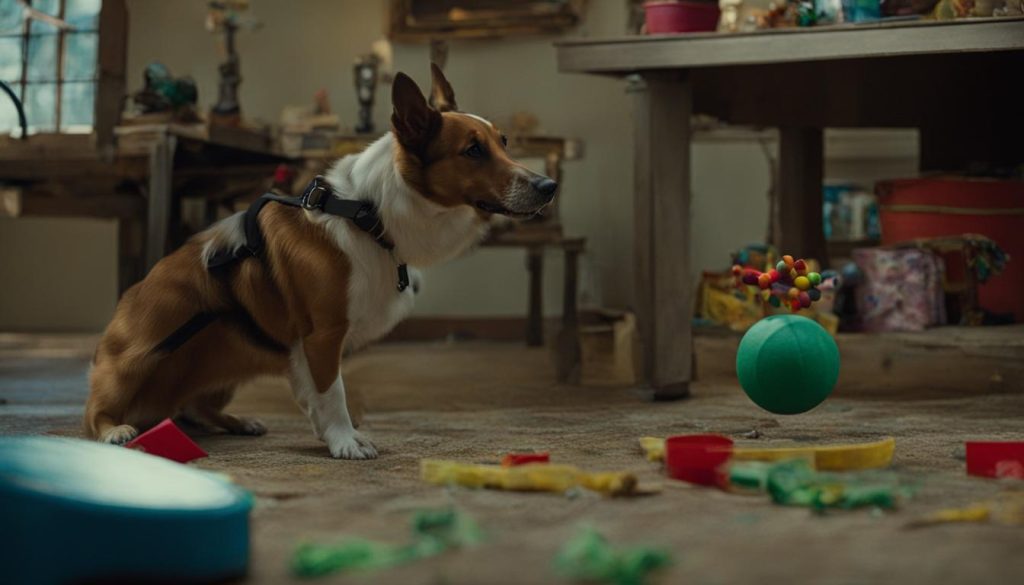
By implementing these troubleshooting tips and following the advice provided, you’ll be well-equipped to teach your dog to find things successfully. Try to stay patient, consistent, and positive throughout the training process. With time and practice, your dog will become proficient in scent detection and object finding, enhancing your bond and making life easier when it comes to locating lost items.
Personal Experience and Success Stories
Teaching your dog to find things can have incredible results, as many dog owners have discovered. One such owner accidentally stumbled upon this training while playing with an old hat. They decided to see if their dog could find the hat based on their scent, and to their amazement, the dog successfully located it! This sparked their curiosity and they began training their dog to find other items with their scent as well. Now, their dog can find lost items around the house in just a matter of minutes.
“Teaching my dog to find things has been a game-changer for me. I used to spend so much time searching for my misplaced car keys or wallet, but now I simply give the command ‘Go find’ and my dog eagerly sniffs out the scent and leads me right to the item. It’s saved me so much time and frustration!” – Dog owner
Another dog owner shared their success story of teaching their dog to find items with specific scents. They trained their dog to detect the scent of a small vial of essential oil and then hide it in various locations. The dog quickly learned to search for the scent and can now find the hidden vial within seconds. This training has not only impressed their friends and family, but also proved to be a valuable skill in daily life.
These success stories highlight the practicality and effectiveness of teaching your dog to find things. The joy and pride that comes from witnessing your dog’s natural scent detection abilities is immeasurable. With patience, consistency, and the right training techniques, you too can experience the thrill of watching your dog confidently locate lost items or specific scents.

Additional Training Resources
When it comes to dog training, having access to reliable resources can make a world of difference in your journey. Whether you’re a beginner or an experienced trainer, these resources can provide valuable guidance and support. Here are two recommended training resources that you can explore:
Adams K-9 Dog Training and Kennel
If you’re looking for a comprehensive training program and boarding services for your dog, Adams K-9 Dog Training and Kennel is an excellent choice. They offer a variety of training programs tailored to different needs and goals, including obedience training, agility training, and even search and rescue training. Their experienced trainers use positive reinforcement techniques to create a positive and enjoyable learning environment for dogs of all ages and breeds.
DoggieBuddy
DoggieBuddy is a website that provides step-by-step instructions and tips for teaching your dog various tricks, including finding lost objects. They offer detailed training guides, videos, and interactive games that can help you enhance your dog’s cognitive skills and overall obedience. From basic commands to more advanced tricks, DoggieBuddy has a wide range of resources to help you train your dog effectively.
To put it simply, while these resources can be incredibly helpful, I would advise that you tailor the training methods to your dog’s unique personality and needs. Be patient, consistent, and always prioritize your dog’s well-being and comfort during training sessions. With the right resources and a positive mindset, you can achieve great success in teaching your dog to find things and strengthen your bond in the process.
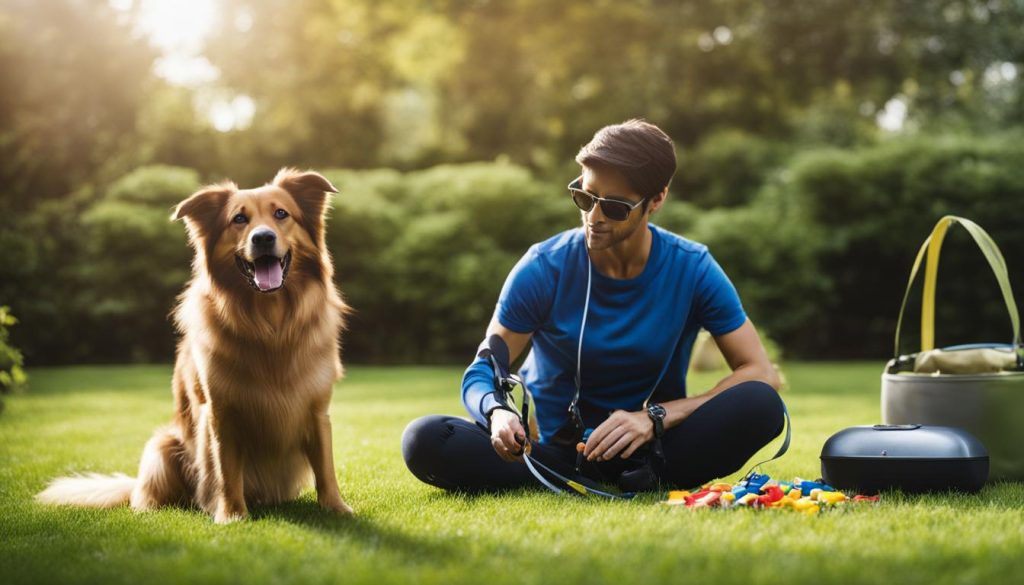
Final Thoughts
To sum it up, teaching your dog to find things is not only a practical skill but also a enjoyable game that strengthens the bond between you and your furry friend. By following some simple dog training tips, such as using scent detection techniques and positive reinforcement, you can train your dog to search for specific scents and locate lost items.
Try to be patient and consistent with your training sessions, gradually increasing the difficulty level as your dog becomes more proficient. Dog nose work tips, such as introducing familiar objects and using consistent command words, can also enhance your dog’s learning experience.
With dedication and practice, your dog can become a skilled searcher, impressing your friends and saving you time when you need to find lost items. So why not start training your dog today? Unleash their scent detection abilities and enjoy the benefits of this practical and rewarding skill!
FAQ
Can any dog learn to find things?
Yes, this skill can be taught to dogs of all breeds and ages.
What tools do I need to train my dog to find things?
You will need a favorite toy or an item that smells strongly of you, treats, and patience.
How do I teach my dog to find objects?
Start by introducing them to the object and letting them sniff it. Hide the object and give the command to find it. Reward your dog when they successfully locate the object.
How do I teach my dog scent tracking?
Have them sniff an object with a specific scent, hide it, and give the command to find it. Reward your dog when they successfully locate the scent.
How do I teach my dog to retrieve lost items?
Hide the item and give the command to find it. If your dog retrieves the item, reward them. If they don’t bring it back, train them to sit in front of you while holding the item and use the command to fetch.
What if my dog is struggling to understand?
Start with familiar objects and gradually introduce new ones. Use consistent command words and be patient. Reward their progress and make the training sessions fun.
Are there any success stories of teaching dogs to find things?
Yes, many dog owners have successfully taught their dogs to find objects and specific scents. These experiences highlight the practicality and effectiveness of this training.
Are there any additional resources for dog training?
Adams K-9 Dog Training and Kennel and DoggieBuddy are two resources that offer comprehensive training programs and step-by-step instructions for teaching various tricks, including finding lost objects.



